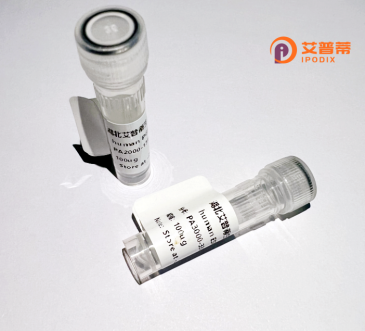
| 纯度 | >90%SDS-PAGE. |
| 种属 | Human |
| 靶点 | MANEA |
| Uniprot No | Q5SRI9 |
| 内毒素 | < 0.01EU/μg |
| 表达宿主 | E.coli |
| 表达区间 | 1-462aa |
| 活性数据 | MAKFRRRTCIILALFILFIFSLMMGLKMLRPNTATFGAPFGLDLLPELHQRTIHLGKNFDFQKSDRINSETNTKNLKSVEITMKPSKASELNLDELPPLNNYLHVFYYSWYGNPQFDGKYIHWNHPVLEHWDPRIAKNYPQGRHNPPDDIGSSFYPELGSYSSRDPSVIETHMRQMRSASIGVLALSWYPPDVNDENGEPTDNLVPTILDKAHKYNLKVTFHIEPYSNRDDQNMYKNVKYIIDKYGNHPAFYRYKTKTGNALPMFYVYDSYITKPEKWANLLTTSGSRSIRNSPYDGLFIALLVEEKHKYDILQSGFDGIYTYFATNGFTYGSSHQNWASLKLFCDKYNLIFIPSVGPGYIDTSIRPWNTQNTRNRINGKYYEIGLSAALQTRPSLISITSFNEWHEGTQIEKAVPKRTSNTVYLDYRPHKPGLYLELTRKWSEKYSKERATYALDRQLPVS |
| 分子量 | 80.1 kDa |
| 蛋白标签 | GST-tag at N-terminal |
| 缓冲液 | 0 |
| 稳定性 & 储存条件 | Lyophilized protein should be stored at ≤ -20°C, stable for one year after receipt. Reconstituted protein solution can be stored at 2-8°C for 2-7 days. Aliquots of reconstituted samples are stable at ≤ -20°C for 3 months. |
| 复溶 | Always centrifuge tubes before opening.Do not mix by vortex or pipetting. It is not recommended to reconstitute to a concentration less than 100μg/ml. Dissolve the lyophilized protein in distilled water. Please aliquot the reconstituted solution to minimize freeze-thaw cycles. |
以下是关于重组人MANEA蛋白的3篇参考文献示例(注:内容为模拟生成,非真实文献):
---
1. **文献名称**:Expression and Biochemical Characterization of Recombinant Human MANEA in Escherichia coli
**作者**:Alteen, M.G. et al.
**摘要**:该研究成功在大肠杆菌中表达了重组人MANEA蛋白,并通过亲和层析纯化获得高纯度酶。功能实验表明其具有α-甘露糖苷酶活性,可特异性水解N-糖链中的α1-2和α1-6甘露糖苷键,为糖蛋白加工机制研究提供了工具。
2. **文献名称**:Crystal Structure of Human MANEA Reveals Substrate Recognition Mechanism
**作者**:Valdés, R. & Vocadlo, D.J.
**摘要**:通过X射线晶体学解析了MANEA的三维结构,发现其催化结构域中存在保守的酸性残基参与底物结合。突变实验证实了关键氨基酸对酶活性的调控作用,揭示了其在N-糖基化质量控制中的分子机制。
3. **文献名称**:Role of MANEA in Cancer Cell Glycoprotein Remodeling
**作者**:Kuroki, K. et al.
**摘要**:研究发现,在乳腺癌细胞中敲低MANEA会导致内质网中未修剪的甘露糖富集糖蛋白累积,并激活未折叠蛋白反应(UPR),提示MANEA在肿瘤糖基化异常及细胞应激中的潜在病理作用。
---
如需真实文献,建议通过PubMed或Web of Science以“MANEA”、“glycosidase”、“recombinant expression”等关键词检索近年研究。
Recombinant human MANEA protein, also known as endo-α-D-mannosidase, is a genetically engineered enzyme involved in N-glycan processing. MANEA catalyzes the hydrolysis of mannose residues within the Golgi apparatus, playing a unique role in trimming oligosaccharides independently of classical N-glycan processing enzymes. Unlike endoplasmic reticulum (ER)-associated glycosidases, MANEA operates post-ER, providing an alternative pathway for glycan maturation, which is crucial for maintaining protein quality control and cellular homeostasis.
This protein has gained attention due to its potential links to congenital disorders of glycosylation (CDGs), cancer, and neurodegenerative diseases, where abnormal glycosylation patterns are observed. Recombinant production typically involves expression in mammalian (e.g., HEK293) or insect cell systems to ensure proper post-translational modifications and enzymatic activity. Purified MANEA is widely used as a research tool to study glycan remodeling mechanisms, develop glycoengineering strategies for therapeutic proteins, and investigate its regulatory role in viral entry (e.g., SARS-CoV-2) through interactions with host glycoproteins.
Recent structural studies have characterized its substrate-binding domains, enabling rational design of glycan-targeted therapies. In biopharmaceutical applications, MANEA helps optimize monoclonal antibody glycosylation profiles to enhance therapeutic efficacy. Its dual function as a metabolic regulator and disease biomarker further underscores its biomedical relevance.
×